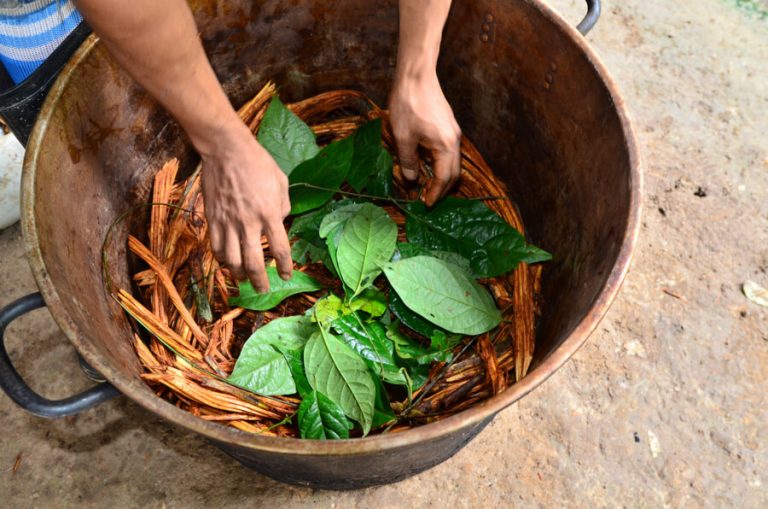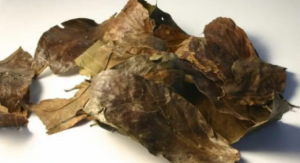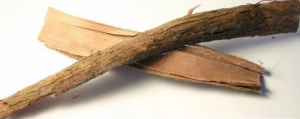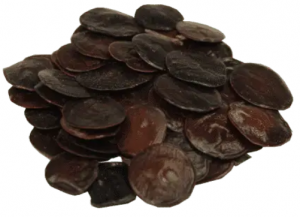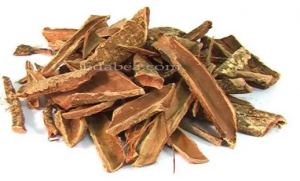Contents
The Holy Medicine of the Holy and Divine Mother Ayahuasca, which is also known as Yage, Yaje, Caapi, Cipo, Bejoco, Hoasca, Natem, and many other names in the Amazons, is a the most powerful Holy Medicine known by humans. The Holy Medicine is the gateway to communicate with the Holy and Divine Mother Ayahuasca.
The Holy Medicine is traditionally prepared by Shamans in the indigenous communities living in the Rainforests of Peru, Brazil, Ecuador, Bolivia, and Colombia and nowadays, the popularity of the Holy Medicine has spread throughout the world over the past few decades. Historically, it evidence and traces have been known that the Holy Medicine was consumed in other regions of the world, using other names such as Soma or Haoma.
When consumed, the Holy Medicine can take the participant of a Sacred Ceremony on a extraordinary journey, decorated with intense emotions and spectacular visions, to meet the Holy and Divine Mother Ayahuasca, and receive Her healing, which cleanses the mind, body, and spirit with profound spiritual insight on how to live life harmoniously. Participants also describe the journey as extraordinary and life-changing experience, in gaining insights and recognizing their life purpose and also helping them make difficult decisions.
Holy Medicine Plant ingredients and chemistry
The main ingredient of the Holy Medicine is the Holy Banisteriopsis Caapi Vine, also known as ‘Aya Waska’ Vine, Yage Vine, which has a history of many thousands of years with the communities of the Amazon who hold Sacred Ceremonies where the Holy Medicine is consumed to meet the Holy and Divine Mother Ayahuasca.
Many other admixtures can also be added to the Holy Medicine to impact the effects of the Holy Medicine. Over hundreds of different medicinal Plants have been added as admixtures in the Holy Medicine. Every admixture from Plant has its own effects and healing properties to offer. Many admixtures from Plant contain N,N-Dimethyltryptamine (DMT), which is one of the most powerful Psychedelic substances occurring in the human body naturally.
The Holy Banisteriopsis Caapi Vine contains many important components with alkaloids like the Harmine, Harmaline and Tetrahydroharmine, which act as MAOI, allowing the DMT in the Holy Medicine, which contain DMT-containing admixture from Plant, to reach the bloodstream to reach the brain.
DMT containing admixtures from Plants
DMT can be found all throughout the plant and animal kingdoms. Some of the most added and well-known sources of DMT from Plants include:
- Psychotria Viridis (Chacruna)– this Plant is an admixture to the Holy Medicine in Peru. Locally it is known as Chacruna, that means “mix” in the indigenous Quechua language.
- Diplopterys Cabrerana (Chaliponga) is also commonly added as a Holy Medicine as admixture from Plant in Colombia and Ecuador. Its local names are Ocoyagé, Chaliponga, Huambisa, and Chagropanga.
- Psychotria Carthagenensis (Amyruca), also known as Sameruca, is a close relative of Psychotria Viridis. This plant contains low levels of DMT which is easy to grow in any condition. For this reason it is popular outside of South America.
- Mimosa Tenuiflora or Mimosa Hostilis (Jurema)– from this Plant, throughout Brazil is prepared Vinho Da Jurema, the local Hallucinogenic Holy Plant Medicine. Aside from N,N-DMT, it also contains β-carbolines, 5-MeO-DMT, and numerous other alkaloids.
- Anadenanthera Peregrina and Anadenanthera Colubrina (Yopo) – from the fruits of these Plants is created of the Yopo powder, which is ritually snuffed by indigenous communities throughout Chile, Argentina, and Colombia. DMT level of these Plants is low.
- Virola Rufula, Virola Calophylla, Virola Theiodora, and a few other Virola species are also added in ritualistic snuffs and by indigenous peoples of the Venezuelan Orinoco Basin.
- Acacia Confusa, Acacia Obtusifolia, Acacia Maidenii, Acacia Simplicifolia, and dozens of other Acacia Species – popularly extracted for DMT in Australia, where they are found in abundance.
 Psychotria Viridis (Chacurna)
Psychotria Viridis (Chacurna)
FAMILY: Rubiaceae
GENUS: Psychotria
SPECIES: Viridis
Other common and local names: Chacruna, Amyruca Panga, Sami Ruca, Kawa, O-pri-to, Suija, Rami Appane, Cahua, Tupamaqui, Horova.
Psychotria Viridis, an evergreen Plant, can grow in a small tree or in a woody trunk. Usually, the size of this plant is 2 to 3 meters. It has narrow leaves and long whorled. The color of the Leaves range from dark green to light green and shiny top—the flowers are greenish but white petals on long stalks. The fruits look like red berry contain many small but long oval seeds. It is native to Amazon forests throughout the Amazon basin, can also be found as far north as Central America and Cuba.
Traditional uses
Psychotria Viridis is one of the most common DMT-containing Plant admixtures that is added in the Holy Medicine around Ecuador, Columbia, parts of Brazil, and Peru. This admixture from Plant is also favored by the churches of the Holy and Divine Mother Ayahuasca, like the Santo Daime and União do Vegetal. Its Leaves provide most of the Hallucinogenic Psychoactive effects in the Holy Medicine. There are also other species of Psychotria that are being added as admixtures but not yet identified scientifically.
Traditional preparation
Shamans sometimes identify this Plant as one of the most suitable for the Holy Medicine by the presence of tiny spine-like shapes on the bottom of the midrib of the leaf. According to Shamans, the leaves must be gathered in the morning and can be added fresh or dry in the Holy Medicine. Locally the leaves are added to produce a thick, tarlike extract that can be smoked.
Medicinal uses
The Machiguenga indigenous community of Peru uses the leaf juices of this plant they call ‘Sampakatishi’ as an eye drop to assist in hunting. This causes a burning sensation which then subsides into heightened physical senses. They use this eye drop to treat migraines too.
Chemical Components and effects
This plant can be quite variable in alkaloid contents. The leaves have yielded 0.11% to 0.34% alkaloids, 0.99% of which may be DMT. There are also traces of 2-methyl-THBC and NMT. The root bark is considerably higher in alkaloid contents.
When ingested in the Holy Medicine, P. Viridis effects include nausea and dizziness, intense hallucinogenic visuals, and states ranging from euphoria to aggression. Most often reported from the participants of Sacred Ceremonies are visions of Snakes and Jaguars, which overpower and attack the individual. The Kogan Indians say that when they consume this Plant as admixture in the Holy Medicine, it allows them to meet the Oprito (small heavenly people).
Diplopterys Cabrerana (Chaliponga)
FAMILY: Malpighiaceae
GENUS: Diplopterys
SPECIES: Cabrerana
Other common and local names: Chagrupanga, Biaxii, Kahi (Tukano, ‘that which causes vomiting), Ka-hee-ko (karapana), Oco-yage (water Yage), Yaco-Ayahuasco, Yahe Vine.
Diplopterys Cabrerana is a long Vine with opposite, oval leaves. The inflorescences each bear four tiny flowers though the plant rarely develops flowers. D. Cabrerana can easily be confused with the Holy B. Caapi Vine. The leaves of D. Cabrerana are wider and larger than the Holy B. Caapi Vine. This plant can only be found in the Amazon basin. Though it grows in the wild, it also can be cultivated in gardens. The wild form prefers to grow around river banks.
Traditional practices
The communities in the Eastern Amazons commonly add Diplopterys Cabrerana as an admixture in the Holy Medicine and to prepare other Psychoactive beverages. The Vine of Diplopterys Cabrerana is a source of N,N-DMT. It is said that a very large amount of DMT can be found in the Vine of this Plant.
Traditional preparation
Many indigenous tribes of the Colombian Amazon, such as Barasana, Desana, and others, use the leaves of D. Cabrerana to prepare high dosages of DMT containing Holy Medicine brews. In the Sibundoy, communities combine the D. Cabrerana Leaves with the Holy Banisteriopsis Caapi Vine to prepare Biaxii.
Chemical components and effects
The leaves of D. Cabrerana contain 0.17% to 1.75% N, N-Dimethyltryptamine, as well as 5-MeO-Dimethyltryptamine, several other alkaloids, and bufotenine. A lower quantity of these alkaloids can also be found in the stems.
When consumed with MAOIs, D. Cabrerana Leaves cause effects ranging from violent nausea to pleasant intoxication. Visual hallucination in vivid color is common. The effects generally end up with deep sleep and vivid visual dreams. Some Shamans avoid using D. Cabrerana because it contains an exceptionally large quantity of DMT, along with the bufotenine and alkaloids 5-methoxy-DMT, both of which are known to bring about adverse effects when mixed with the Holy Medicine.
 Psychotria Carthagenensis (Amyruca)
Psychotria Carthagenensis (Amyruca)
FAMILY: Rubiaceae
GENUS: Psychotria
SPECIES: Carthagenensis
Other common and local names: Amyruca, Rami appane, Sameruca, Wy-soo-do, and Yage-Chacruna.
Psychotria Carthagenensis is closely related to Psychotria Viridis and an evergreen South American rainforest underwood shrub from the Rubiaceae coffee family. It grows in the tropics of Mexico to Cuba, Costa Rica, El Salvador, Honduras, Nicaragua, Panama, Colombia, Bolivia, Paraguay, Peru, Ecuador, Venezuela. This Plant is small but dense, flat-topped crown which can usually grow 30cm to 12 meters tall.
Traditional uses
The Leaves of this Plant contain a small amount of DMT and are often added to the Holy Medicine, to ‘strengthen’ and ‘lengthen’ the effects credited to be produced by DMT.
This is the only Psychotria species with no alkaloids.
Mimosa Hostilis (Jurema)
FAMILY: Leguminosae
GENUS: Mimosa
SPECIES: Hostilis, Tenuiflora
Other common and local names: Jurema Tree, Cabero (goatherd), Carbon (charcoal), Tepescohuite.
The Mimosa Hostilis is a bushy Plant that can grow up to 8 meters in height. It has pinnate leaves and short, sharp thrones on the branches. The flowers whitish and grow in clusters, and the fruits are small with 5 to 7 mm long and 2 to 4.5 mm wide. Mimosa Hostilis is found in southern Mexico, Brazil, Venezuela, and Central America. It usually grows best in tropical lowlands but can also be found at altitudes of up to 1000 meters.
Traditional uses
The first Brazilian communities to develop a specific ritualistic use of Jurema as Psychoactive brew are extinct. Jurema is referred to a Plant, an herbal potion, a spirit, and a spiritual tradition. This timeless wisdom was secretly conserved from father to son, as the ritualistic use of their Psychoactive brew brought severe prosecution from the White Men.
There are fascinating similarities between the Sacred Ceremonies, where the Holy Medicine is consumed, and these Jurema rituals of the Amazon forest. The Jurema rituals show all the characteristics of Psychoactive influence though alcohol is also drunk to induce an altered state of consciousness. According to their belief, alcohol is the only available medium through which rituals can be enhanced, and attendant spirits are served.
Traditional Preparation
The preparation of the Jurema brew from fresh Jurema root bark is a complex ritual. Usually, these rituals are aimed to achieve a trance possession state. At the bottom of the mountain Oma, the process of these kinds of rituals begins by O Paje, the spiritual leader. Only those roots that are facing the rising sun are picked. After picking up, the roots are beaten against a rock to remove all dirt off the root. Only the inner root is added for the Brew. It is believed that by taking this brew in the rituals, Jurema people can beckon the spirits of the Caboclos called ‘Encantados de Luz’ (Enchanted Beings of Light) to descend into the bodies of the participants to promote healing while dancing the Tore.
A strong wine is made with passionfruit juice and Mimosa Hostilis in Brazil. The Holy Medicine analog may also be made by combining 3 grams of Peganum harmala with 9 to 12 grams of dried Mimosa Hostilis root cortex. It is recommended to consume the Holy Medicine with honey to counteract the unpleasant taste of the bark. It is said that this bark causes more nausea when the Holy Medicine is consumed containing Mimosa Hostilis, compared with Holy Medicine containing other popular DMT-containing admixtures from Plants.
Medicinal uses
In Mexico, the powdered bark of Mimosa Hostilis helps to treat wounds and burns with miraculous results. The bark is also taken in capsules for debility and exhaustion. In Brazil, women, as an aphrodisiac, rub the fresh root cortex onto the soles of men they desire.
Chemical components and effects
A number of constituents, including steroid saponins and triterpene saponins. The bark also contains large quantities of starch, calcium, and tannins, and small quantities of alkaloids, including 5-hydroxytryptamine, N,N-Dimethyltryptamine, and Beta-carbolines are also included. In recent studies, R. Anton and his team yielded 1% of N, N-DMT from the root cortex of Mexican samples, which is a phenomenal amount.
According to the old stories and literature, the Jurema drinks that were traditionally made in the eastern Amazon provided the Shamans with amazing dreams and transported them to heaven. When the powdered root spread on burns, it creates analgesic effects that last for up to three hours. It also noticeably shortens the regeneration time for the skin. The bark also stimulates the immune system. In modern times, the root concoction added to passion fruit juice would likely act as an MAOI and can give psychedelic effects.
Anadenanthera Peregrina (Yopo)
FAMILY: Fabaceae (Legume)
GENUS: Anadenanthera
SPECIES: Colubrina, Peregrina
Other common and local names: Hakudufha, Cohoba, Niopo, Kahobba, Yopa, Parica, Yopo, Una de Gato (cat claw), Villca.
The Anadenanthera Colubrina tree has black bark with thrones and knotty constrictions and grows from three to eighteen meters. The leaves are quite long and pinnate. A. peregrina and A. Colubrina are very similar in appearance and are hard to distinguish from each other. At night, the leaves of these trees fold together and open up in the morning. Glands on the stems release sweet nectar, which attracts the ants to consume it, and in return, the ants destroy pests that might harm the tree. When the pods of these trees are ripe, they become gray-black, and they break open and expose three to ten flat seeds. These are gathered in large quantities during January and February.
Traditional uses
A very potential Hallucinogenic snuff is prepared from the seeds of the A. Peregrina tree. The snuff was first reported from Hispaniola around 1496, where the Taino Indians used to call it Cohoba—mainly present in the Orinoco basin.
An early Peruvian report, dated around 1571, stated that Inca medicine men were able to predict the future by connecting with the ‘devil’ through the use of Villca. In Argentina, the early Spaniards found that many tribes chewed this plant for endurance, and the Comechin Indians taking dispensers of this same Plant through the nose to become intoxicated. Villca seeds were added to a ceremonial maize beer called Chicha. By drinking Chicha, Shamans were able to foretell the future. The Shamans of the Wichi tribe in Argentina still use a snuff made from A. Peregrina; they call Hataj, which let them penetrate other realities and influence those realms.
Traditional preparation
The preparation of Anadenanthera differs from tribe to tribe. After collecting the pods, they are moistened and rolled into a paste and then roasted gently over a slow fire until it is completely dried out. After the toasting, the hardened paste is usually stored for later use. Some tribes toast the seeds and crush them into a paste. The final grayish-green powder is always mixed with about equal amounts of some alkaline component like lime from snail shells or the ashes of plant material. However, in the case of Yopo snuff, the alkaline admixture does not seem to be essential. Some tribes, such as the Guahibos, may occasionally take the powder alone. Yopo snuff is inhaled through hollow bird-bone of bamboo tubes.
Medicinal uses
A hot beverage made from Villca seeds is great for healing digestive troubles when the seeds combined with Chicha brew may also help overcome melancholy, fever, and unknown afflictions. By adding the seeds to the honey and consuming it can increase female fertility. The gum of A. Colubrina helps to treat cold and coughs, while the snuff helps to treat constipation, headaches, and flu.
Chemical components and effects
The hallucinogenic effects found in A. Peregrina seeds include N-monomethyltryptamine, N,N-dimethyltryptamine, 5-methoxydimethyltryptamine, bufotenine, and several other related bases. Only recently, the elucidation of the chemical make-up of the seeds of the Yopo tree has been accomplished.
After taking the Yopo snuff, the effects begin almost immediately: slight convulsions, twitching of the muscles, and lack of muscular coordination, followed by visual hallucinations, nausea, and disturbed sleep. After taking the snuff, the effects of macropsia are common.
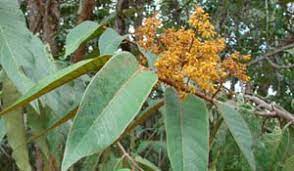 Virola Theiodora
Virola Theiodora
FAMILY: Myristicaceae
GENUS: Virola
SPECIES: Theiodora, Rufula, Calphylla.
Other common and local names: Cumala Tree, Yakohana, Parika
If not all, most of the Virola species have a copious red ‘resin’ in the inner bark. This resin of a number of species is produced as a hallucinogenic snuff. The most largely added species is said to be Virola Theiodora. This plant is slender, 7.5 meters to 23 meters in height, native to the western Amazon basin. The trunk is 46cm in diameter, with smooth bark which is brown. The male inflorescences are many-flowered, usually gold or brown, shorter than the leaves. Members of this genus are mostly found in Amazonian and adjacent areas. Some species also grow in Central America. One specific species, Virola guatemalensis, can be found in Guatemala and southern Mexico.
Traditional uses
According to the Tukano, Viho or the Virola snuff enables the Shamans to consults the spirit world, especially one particular deity known as ‘Viho-Mahse’ who lives in the Milky Way. When a Shaman wants to contact the spirits, he must first contact Viho-Mashe. This snuff is one of the most important ways of the Paye (Medicine worker). It is only in adjacent parts of the Orinoco basin and in the western Amazon that this genus has been considered as an Entheogen. V. Theiodora is the most frequently added species, though there are other species that are also effective. The mythological significance and magico-religious practice of this snuff tell us that it has been in practice since ancient times, and the substance only recently began to receive considerations from researchers.
In northwest Brazil, along with this snuff, other entheogenic snuffs are usually called Parica. Though the Colombian Indians restricted the use of this snuff to Shamans, only they use the substance in daily life. The substance is often taken in large amounts in at least one annual ceremony.
Traditional preparation
The Columbians strip the bark from the trees and scrape the soft inner layers in the early morning. The shavings are kneaded in cold water for twenty to thirty minutes. The brownish liquid is then filtered and boiled down to a thick syrup which is then dried, pulverized, and mixed with the ashes of the bark of a wild cacao tree.
Various communities of the Waika tribe have their own several methods of preparation. But most of the methods include pulverizing the syrup and mix the powder with equal amounts of a powder prepared from the dried, aromatic leaves of a small plant such as Justicia pectoralis so that the powder smells better.
The Desana of Colombia combines the inner bark of Virola Calophylla and Virola theiodora with powdered Nicotiana tabacum, Cecropia leaf ash, powdered coca leaves, powdered Holy Banisteriopsis Caapi Vine to snuff them all together.
Medicinal uses
The resin of the Virola genus plays a very important role in tribal medicine, particularly as an antifungal. The resin is spread over infected areas of the skin to cure dermatological problems of fungal origin, which are common in humid tropical rain forests. Only specific species are chosen for this healing use, and the choice seems not to have any relationship to the psychoactive properties of the species.
The bark of various species is also boiled to dispel evil spirits and smoked to reduce fevers. Many species are there to help improve memory and intelligence and stimulant the mind.
Chemical components and effects
The psychoactive effects of Virola snuff are said to be the result of an exceptionally high concentration of tryptamine alkaloids present in the resin. Snuff prepared from Virola Theiodora can have up to eight percent tryptamine alkaloids, including 5-MeO-DMT and N,N-DMT. Two alkaloids found in the resin act as MAOI, which allow the resin to have a Psychedelic effect when consumed orally.
Schultes reported that the effects of the snuff were very intense and not at all pleasant. The effects of Virola snuff are observable within minutes of initial use. One first experiences increased excitability, followed by un uncontrollable twitching of the face, numbing of the limbs, nausea, a lack of muscle control, and often vomiting. Macropsia, or seeing objects in the visual field enlarged, is the key characteristic of Virola snuff use.
Acacia Spp.
FAMILY: Leguminosae
GENUS: Acacia
SPECIES: Confusa, obtusifolia, maidenii, simplicifolia, etc.
Other common and local names: Timbre, Pulque, Catechu Tree, Acacia, Horned Acacia, Maiden’s Wattle, Druce
The genus Acacia encompasses from 100 to 800 species found all over the world. Most Acacia trees are medium-sized, with clustered flowers and pinnate leaves. They bear pod-like fruits. The flowers are fragrant and are often made into an essential oil that is helpful in aromatherapy.
Traditional uses
Numerous Acacia species have been considered as Medicine and as Entheogens as well as for making incense. Most of the Acacia species of the Australian region contain DMT and other tryptamines and are therefore suitable as ingredients in the Holy Medicine. However, not all Acacia species contain DMT.
In Mexico, the root of A. Angustifolia is added as an additive to Pulque, a psychoactive fermented agave beverage. This beverage is said to have interesting psychoactive effects. The leaves of A. Campylacantha contain N,N-DMT, and other alkaloids, and the bark is added in West Africa as a Psychoactive additive to a Psychoactive beverage known as Dolo. The gum of A. Nilotica is fried in ghee consumed as an aphrodisiac, and the tree is considered sacred and is not to be cut down.
A. Cornigera is a South American species added in the preparation of the Mayan ritual drink known as Balche. It has been proposed that the burning bush witnessed by Moses in the Old Testament was an A. Senegal tree. This tree is still held sacred in the Middle East, and locally it is said that anyone who breaks off a branch will die in a year.
Medicinal uses
In India, Acacia catechu is considered as a juice for digestive ailments, to treat ulcers in the mouth, to treat skin disorders, toothaches, and inflamed throats. This plant contains plenty of tannins and so is suitable for treating inflammations.
In Africa, A. Ataxacantha root is combined with other herbs to treat wounds. The leaf is an analgesic. A. Nilotica in Sudan helps to treat a variety of different inflammatory disorders. The Masai use a decoction of the stem bark and root to acquire courage and as a stimulant.
Chemical components and effects
Many African species of Acacia are said to have very stimulating and energizing effects, although some individuals are also said to go mad from chewing the bark and even to fall comatose in rare cases. Species such as A. Acuminata, A. Albida, and A. Maidenii have been found to contain DMT and so may potentially be useful as an admixture in the Holy Medicine, although reports on the effectiveness of this practice seem to vary widely from case to case.
Conclusion
DMT is known to be found in all mammals, and in various Plants from all over the world which have been consumed by humans throughout history. The DMT admixtures from Plants in the Holy Medicine is traditionally known to be learnt by the Shamans directly from the Holy and Divine Mother Ayahuasca.
References:
- Anton, R.Y., B. Jiang, J.P. Weniger, J.P. Beck, and L. Rivier. (1993). Pharmacognosy of Mimosa Tenuiflora (Willd.) Poiret. Journal of Ethnopharmacology, [online] Volume38 (1993), p. 153–157. Available at: https://www.sciencedirect.com/science/article/abs/pii/0378874193900103 [Accessed 11th May 2021]
- Hofmann, A., Ratsch, C., Schultes, R. (1992). Plants of the Gods: Their Sacred, Healing, and Hallucinogenic Powers. Rochester: Healing Arts Press.
- Pinkley, H.V. (1969). Etymology of Psychotria in View of a New Use of the Genus. Rhodora 71, [online] p. 535–540. Available at: https://www.biodiversitylibrary.org/part/186778 [Accessed 10th May 2021]
- Plotkin, M.J., and R.E. Schultes. (1990). Virola: A Promising Genus for Ethnopharmacological Investigation. Journal of Psychoactive Drugs, [online] Volume 22 (1990), p. 356–361. Available at: https://www.tandfonline.com/doi/abs/10.1080/02791072.1990.10472561 [Accessed 11th May 2021]
- Ratsch, Christian. (1998). The Encyclopedia of Psychoactive Plants: Ethnopharmacology and its Applications. Rochester: Park Street Press.
- Reichel-Dolmatoff, G. (1979). Some Source Materials on Desana Shamanistic Initiation. Antropologia, [online] Volume 51(1979), p. 27–61. Available at: https://biblat.unam.mx/en/revista/antropologica-caracas/articulo/some-source-materials-on-desana-shamanistic-initiation [Accessed 11th May 2021]
- Russo, E.B. (1997). An Investigation of Psychedelic Plants and Compounds for Activity in Serotonin Receptor Assays for Headache Treatment and Prophylaxis. Maps 7, [online] Volume 1, p. 4–8. Available at: https://maps.org/news/bulletin/articles/448-bulletin-winter-1996/8559-schedule-1-research-protocol-an-investigation-of-psychedelic-plants-and-compounds-for-activity-in-serotonin-receptor-assays-for-headache-treatment-and-prophylaxis [Accessed 10th May 2021]
- Safford, W.E. (1916). Identity of Cohoba, the Narcotic Snuff of Ancient Haiti. Journal of the Washington Academy of Sciences, [online] Volume 6 (1916), p. 547–562. Available at: https://www.samorini.it/doc1/alt_aut/sz/safford_coh.htm [Accessed 11th May 2021]
- Schultes, R.E. (1954). A New Narcotic Snuff from the Northwest Amazon. Botanical Museum Leaflets, [online] Volume 16, no. 9 (1954), p. 241–260. Available at: https://www.jstor.org/stable/41762155?seq=1 [Accessed 11th May 2021]
- Schultes, R.E. (1976). The Golden Guide Hallucinogenic Plants. Houston: Golden Press.
- Voogelbreinder, Snu. (2009). Garden of Eden: The Shamanic Use of Psychoactive Flora and Fauna, and the Study of Consciousness. Sydney: Snu Voogelbreinder.
- Wahba Khalil, S.K., and Y.M. Elkheir. (1975). Dimethyltryptamine from the Leaves of Certain Acacia Species of Northern Sudan. Lloydia, [online] Volume 28, no. 2 (1975), p. 176–177. Available at: https://pubmed.ncbi.nlm.nih.gov/1055855/ [Accessed 11th May 2021]

